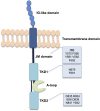Therapeutic Targeting of FLT3 in Acute Myeloid Leukemia: Current Status and Novel Approaches
- PMID: 36474506
- PMCID: PMC9719701
- DOI: 10.2147/OTT.S384293
Therapeutic Targeting of FLT3 in Acute Myeloid Leukemia: Current Status and Novel Approaches
Abstract
FMS-like tyrosine kinase 3 (FLT3) is mutated in approximately 30% of acute myeloid leukemia (AML) patients. The presence of FLT3-ITD (internal tandem duplication, 20-25%) mutation and, to a lesser extent, FLT3-TKD (tyrosine kinase domain, 5-10%) mutation is associated with poorer diagnosis and therapy response since the leukemic cells become hyperproliferative and resistant to apoptosis after continuous activation of FLT3 signaling. Targeting FLT3 has been the focus of many pre-clinical and clinical studies. Hence, many small-molecule FLT3 inhibitors (FLT3is) have been developed, some of which are approved such as midostaurin and gilteritinib to be used in different clinical settings, either in combination with chemotherapy or alone. However, many questions regarding the best treatment strategy remain to be answered. On the other hand, various FLT3-dependent and -independent resistance mechanisms could be evolved during FLT3i therapy which limit their clinical impact. Therefore, identifying molecular mechanisms of resistance and developing novel strategies to overcome this obstacle is a current interest in the field. In this review, recent studies of approved FLT3i and knowledge about major resistance mechanisms of clinically approved FLT3i's will be discussed together with novel treatment approaches such as designing novel FLT3i and dual FLT3i and combination strategies including approved FLT3i plus small-molecule agents targeting altered molecules in the resistant cells to abrogate resistance. Moreover, how to choose an appropriate FLT3i for the patients will be summarized based on what is currently known from available clinical data. In addition, strategies beyond FLT3i's including immunotherapeutics, small-molecule FLT3 degraders, and flavonoids will be summarized to highlight potential alternatives in FLT3-mutated AML therapy.
Keywords: AML; FLT3 inhibitor; FLT3-ITD; FLT3i resistance; flavonoid; targeted therapy.
© 2022 Tecik and Adan.
Conflict of interest statement
The authors report no conflicts of interest in this work.
Figures
References
-
- Leick MB, Levis MJ. The future of targeting FLT3 activation in AML. Curr Hematol Malig Rep. 2017;12(3):153–167. - PubMed
Publication types
LinkOut - more resources
Full Text Sources
Miscellaneous




